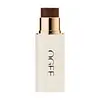What's inside
What's inside
 Key Ingredients
Key Ingredients

 Benefits
Benefits

 Concerns
Concerns

 Ingredients Side-by-side
Ingredients Side-by-side

Caprylic/Capric Triglyceride
MaskingSimmondsia Chinensis Seed Oil
EmollientCera Alba
EmollientSucrose Tetrastearate Triacetate
EmollientC13-14 Alkane
SolventOlea Europaea Fruit Oil
MaskingCopernicia Cerifera Wax
C18-21 Alkane
SolventOryza Sativa Bran Wax
Skin ConditioningSambucus Nigra Fruit Extract
AstringentCoffea Arabica Seed Oil
MaskingSilica
AbrasivePentaclethra Macroloba Seed Oil
EmollientPogostemon Cablin Leaf Extract
PerfumingShorea Robusta Resin
TonicOctyldodecanol
EmollientOleic/Linoleic/Linolenic Polyglycerides
EmollientHelianthus Annuus Seed Oil
EmollientTocopherol
AntioxidantBeta-Sitosterol
Emulsion StabilisingSqualene
EmollientMica
Cosmetic ColorantCaprylic/Capric Triglyceride, Simmondsia Chinensis Seed Oil, Cera Alba, Sucrose Tetrastearate Triacetate, C13-14 Alkane, Olea Europaea Fruit Oil, Copernicia Cerifera Wax, C18-21 Alkane, Oryza Sativa Bran Wax, Sambucus Nigra Fruit Extract, Coffea Arabica Seed Oil, Silica, Pentaclethra Macroloba Seed Oil, Pogostemon Cablin Leaf Extract, Shorea Robusta Resin, Octyldodecanol, Oleic/Linoleic/Linolenic Polyglycerides, Helianthus Annuus Seed Oil, Tocopherol, Beta-Sitosterol, Squalene, Mica
Alternatives
Ingredients Explained
These ingredients are found in both products.
Ingredients higher up in an ingredient list are typically present in a larger amount.
Cera alba is beeswax, or the wax used by bees to make honeycombs. It is a texture-enhancer and emollient. A study from 2003 found beeswax to be a stronger emollient than ingredients such as petroleum jelly.
As an emollient, beeswax helps hydrate the skin by creating a barrier on top. This barrier traps moisture in.
Emulsifiers help prevent ingredients from separating. This helps create consistent texture.
The structure of beeswax is mainly long-chain alcohols and the esters of fatty acids.
There are three types of beeswax: yellow, white, and absolute. Yellow is pure beeswax taken from the honeycomb. White beeswax is created by filtering or bleaching yellow beeswax. Absolute beeswax is created by treating beeswax with alcohol. Beeswax used in cosmetics are purified.
Beeswax has been used throughout history and even in prehistoric times. Some common uses for beeswax still used today are making candles, as a waterproofing agent, and polish for leather.
Learn more about Cera AlbaThis oil comes from the seeds of the desert shrub called Jojoba. It is more commonly known as jojoba oil, a non-comedogenic oil.
Jojoba oil does not contain fragrance and has many fatty-acids, making it a great soothing ingredient.
It also contains Vitamin E, a great moisturizing ingredient. Vitamin E is also an antioxidant and protects your skin against oxidative damage.
This ingredient humectant properties, meaning it helps draw moisture from the air. This helps keep your skin hydrated.
While jojoba has antibacterial properties, it is only able to kill some strains of bacteria.
Studies also show it helps in wound healing. In fact, Indigenous cultures have used jojoba as a moisturizer and to help treat burns for centuries.
Fun fact: Jojoba oil similar to natural human skin sebum, so it has a great effect on dry skin. It is also promising with helping to regulate sebum production.
Due to its fatty acid content, Jojoba oil may not be fungal acne safe. We recommend speaking with a professional if you have any concerns.
Learn more about Simmondsia Chinensis Seed OilTocopherol (also known as Vitamin E) is a common antioxidant used to help protect the skin from free-radicals and strengthen the skin barrier. It's also fat soluble - this means our skin is great at absorbing it.
Vitamin E also helps keep your natural skin lipids healthy. Your lipid skin barrier naturally consists of lipids, ceramides, and fatty acids. Vitamin E offers extra protection for your skin’s lipid barrier, keeping your skin healthy and nourished.
Another benefit is a bit of UV protection. Vitamin E helps reduce the damage caused by UVB rays. (It should not replace your sunscreen). Combining it with Vitamin C can decrease sunburned cells and hyperpigmentation after UV exposure.
You might have noticed Vitamin E + C often paired together. This is because it is great at stabilizing Vitamin C. Using the two together helps increase the effectiveness of both ingredients.
There are often claims that Vitamin E can reduce/prevent scarring, but these claims haven't been confirmed by scientific research.
Learn more about Tocopherol